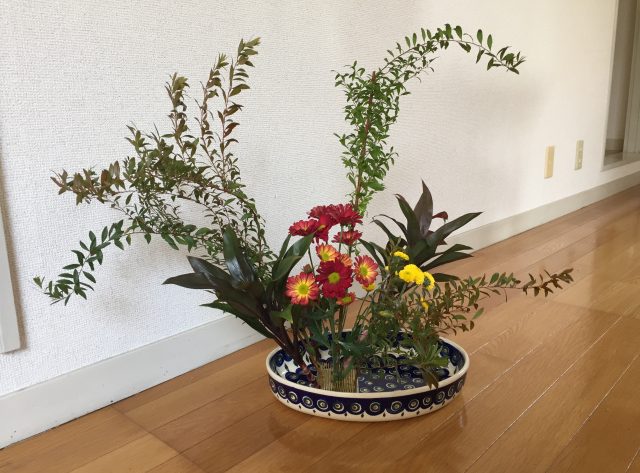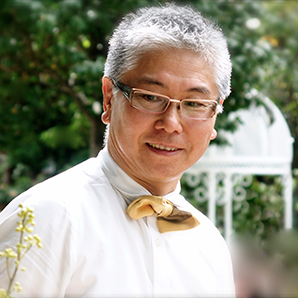Depending on the translation, ikebana means either arranging flowers (yawn) or living flowers (yay!). Western-style floral arrangements seem to emphasize overstuffed vases with huge amounts of gorgeous but ridiculously expensive flowers. You stuff flowers into a vase until it’s full, perhaps adding some leaves or other filler. More is more.
By contrast, ikebana focuses on balancing the arrangement’s components with the space around them. First you arrange the stems, which are literally sticks or twigs of some kind, usually whatever is in season. Then come the flowers, but only three flowers or so. Finally you fill in with some leaves. The space around each stem and flower defines each element and gives the viewer the chance to enjoy the arrangement, to paraphrase our instructor.
Ikebana arrangements begin with formulas. The size and shape of the container dictates the length of the stems, which in turn dictate the lengths of the flowers. The positions of each stem and flower also begin with formulas—angles, positions to the right and left, and so on. While some people chafe against such rigid rules, I love a framework.
My instructor Sakiko Kamata at Saint Maur International School in Yokohama near Tokyo, which offers adult enrichment programmes, has taught ikebana for years, as outlined in this interview in The Japan Times. She loves teaching and sharing her skills with her students, and her infectious laugh makes each class so much fun.
During class we watch a demonstration by Kamata-sensei, assemble that week’s arrangement according to The Rules, then call her over when we think we have it right. She always offers praise, then makes adjustments. Sometimes it’s a stem or two moved over slightly, or a bushy leaf snipped down just a tad. Other times it ends up a complete re-do. We students snap a few photos, then disassemble the arrangement and hope that we can recreate it at home.
Every class Kamata-sensei praises at least one student loudly and sincerely: “Everyone, come here! It’s Kristi’s final tall vase arrangement, and look how well she did”. Or: “Everyone, look at Marta’s notebook. She is so dedicated”. We gather around and admire the arrangement and graciously accept her compliments.
I also enjoy the mix of parents that ikebana draws. Some of the class members have practiced for years, and their arrangements reflect their dedication. Sometimes I find it awkward to chat with someone with my terrible Japanese and their not-so-great English, struggling to find something to say. But standing in front of a stunning arrangement makes it easy, because it doesn’t take much to say, “This is so beautiful. You did a great job”.
Japan has a well-earned reputation of being a shockingly expensive place to live in or visit, but here’s a secret: flowers are surprisingly cheap, and abundant. Even the humblest blooms can shine in a classic, minimal ikebana arrangement. The flowers, stems and leaves for a killer ikebana arrangement can cost as little as ¥1,000.







